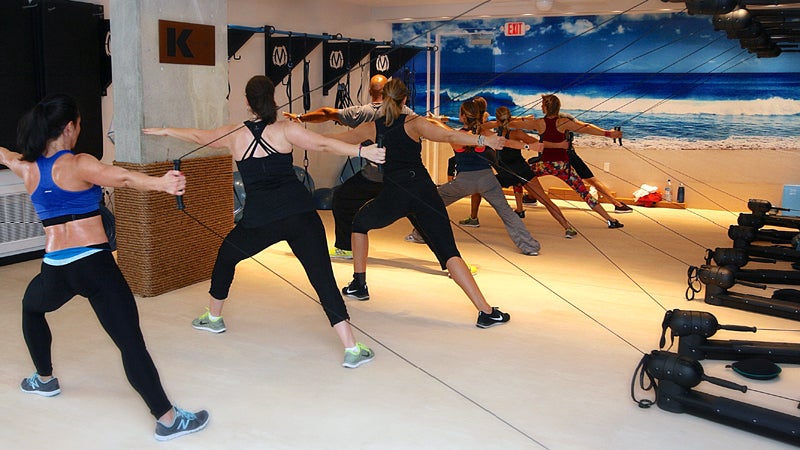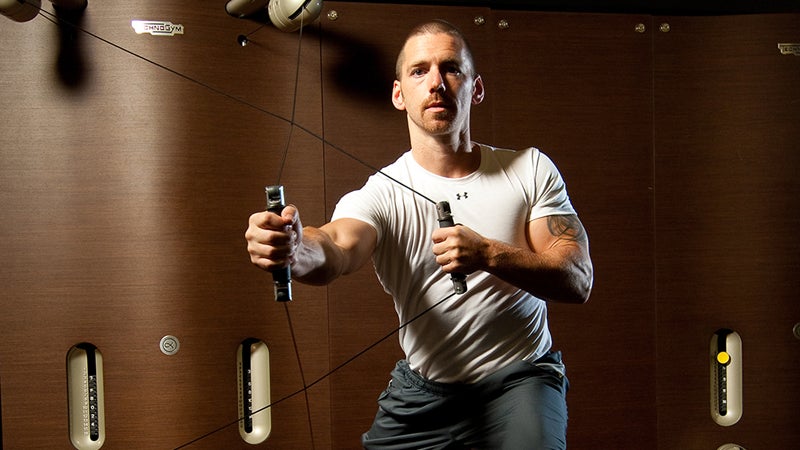When I threw out my back for the first time last fall, I hadn’t had a gym membership for years. “Cycling makes me fit,” I’d reasoned, until picking up a small cardboard box laid me out for five days. I reconsidered my defintion of strength: I could ride a mountain bike for six hours, but could I get through day-to-day life without hurting myself?
Getting stronger not just for sport but also life is the goal behind kinesis, one of the newest trends in functional training, a workout performed on and around the dual-cable Technogym Kinesis® machine. The company’s design increases resistance as you move further from the machine, and unlike traditional cable systems and weightlifting, the 360-degree pivoting pulleys generate resistance in all directions. This enables the user to develop strength in almost any three-dimensional movement.
At , a kinesis gym in Santa Monica, California, owner Susan Howard says, “We’re working on functional movement patterns that allow us to be more dynamic and efficient in everything that we do, whether it’s hiking, kayaking, rock climbing, picking up your child, or going up a flight of stairs.” Howard calls her program “lifestyle performance enhancement”.

Participants perform a mix of high-intensity speed, power, and agility work; with low-intensity movements for strength, flexibility, balance, and core stability. Attached by the waist to the cables, they skip, jump, and move side to side. They also do strength work like rows, lunges, squats, and presses, on and off the machine.
Kinesis appeals to the causual fitness crowd, but ironically, it may be serious athletes who need this kind of functional workout the most.
“A lot of times elite athletes who are only doing their sport get stuck in repetitive patterns in a single plane of motion—think of someone riding a bike,” says functional training specialist Dawna Graham, who teaches kinesis at in Boulder, Colorado.
“Functional training like kinesis moves you in three dimensions and helps you to achieve full range of motion in all your joints.” This makes the body more efficient, able to recruit more muscle and power for the same amount of energy.
The other key element of kinesis is core stability. The core is engaged in every movement in kinesis—needed to balance and stabilize the entire body in performing a single-arm pull, for example.
These dual benefits of mobility and stability facilitate power transfer from one part of the body to another in sports and daily functions. They’re also key to injury prevention.
“Shoulders, hips, and feet can get tight or injured from sport-specific training,” says Erin Carson, fitness director and co-owner at RallySport. This tightness and muscular imbalance can make seemingly “strong” individuals vulnerable to injury from non-sport related movements—like lifting a cardboard box.
That’s why ensuring optimal mobility and stability with a program like kinesis is the first step to building a stronger athlete, says Carson, who has applied this philosophy to conditioning elite athletes like Mirinda Carfrae, 2013 IRONMAN World Champion.
RallySport recommends kinesis once a week as a supplement to aerobic training, and at a lower intensity than CrossFit or boot camp, it won’t wear you out for your sport training.
At some point, Carson says, you will need to progress beyond kinesis to keep making strength gains—but pure strength isn’t the point of this workout. Kinesis means “movement”, and the more of your life you spend in motion, the more you stand to gain by becoming more well-rounded and efficient in that motion.


